SBM1202 Report: Sustainable Procurement Practice in Australia
VerifiedAdded on 2022/11/29
|14
|3970
|479
Report
AI Summary
This report provides a comprehensive analysis of sustainable procurement practices within Australia, examining its implementation across various sectors. It begins by exploring the significance of sustainable procurement in the context of the Australian government's focus on sustainable development and waste management, highlighting the shift towards considering the entire life cycle of goods and services. The report delves into sustainable supply chain management (SSCM), discussing its increasing importance in both government and private organizations, along with the challenges and the need for effective frameworks. It then investigates the application of sustainable procurement in road construction, identifying barriers and highlighting the need for standardized practices. Furthermore, the report examines sustainable procurement within the public sector, emphasizing its role in achieving social goals and stimulating environmentally sound practices. Finally, it explores the role of universities in promoting sustainable procurement. The report draws upon various studies to provide a holistic overview of the current state and future directions of sustainable procurement in Australia.
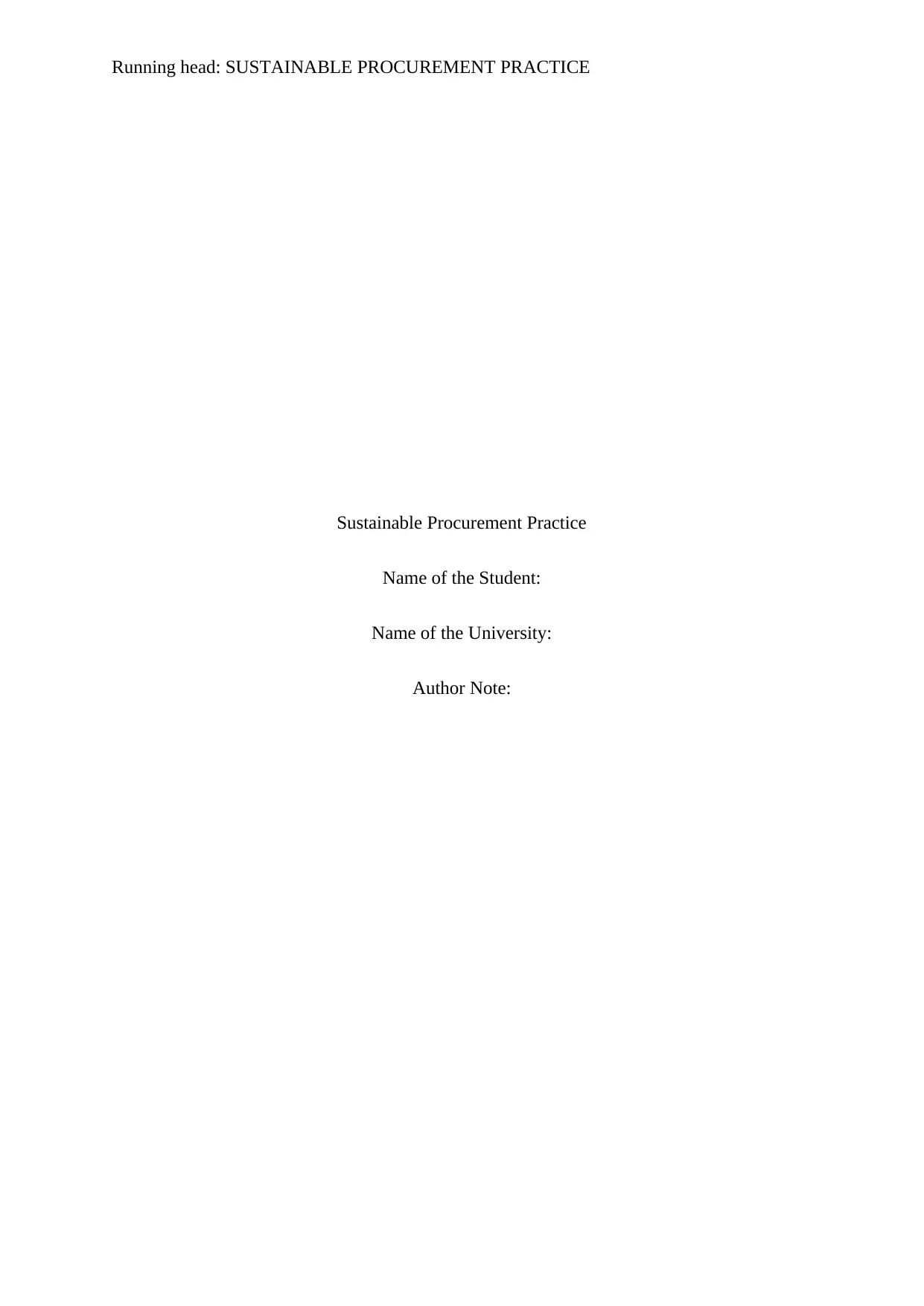
Running head: SUSTAINABLE PROCUREMENT PRACTICE
Sustainable Procurement Practice
Name of the Student:
Name of the University:
Author Note:
Sustainable Procurement Practice
Name of the Student:
Name of the University:
Author Note:
Paraphrase This Document
Need a fresh take? Get an instant paraphrase of this document with our AI Paraphraser
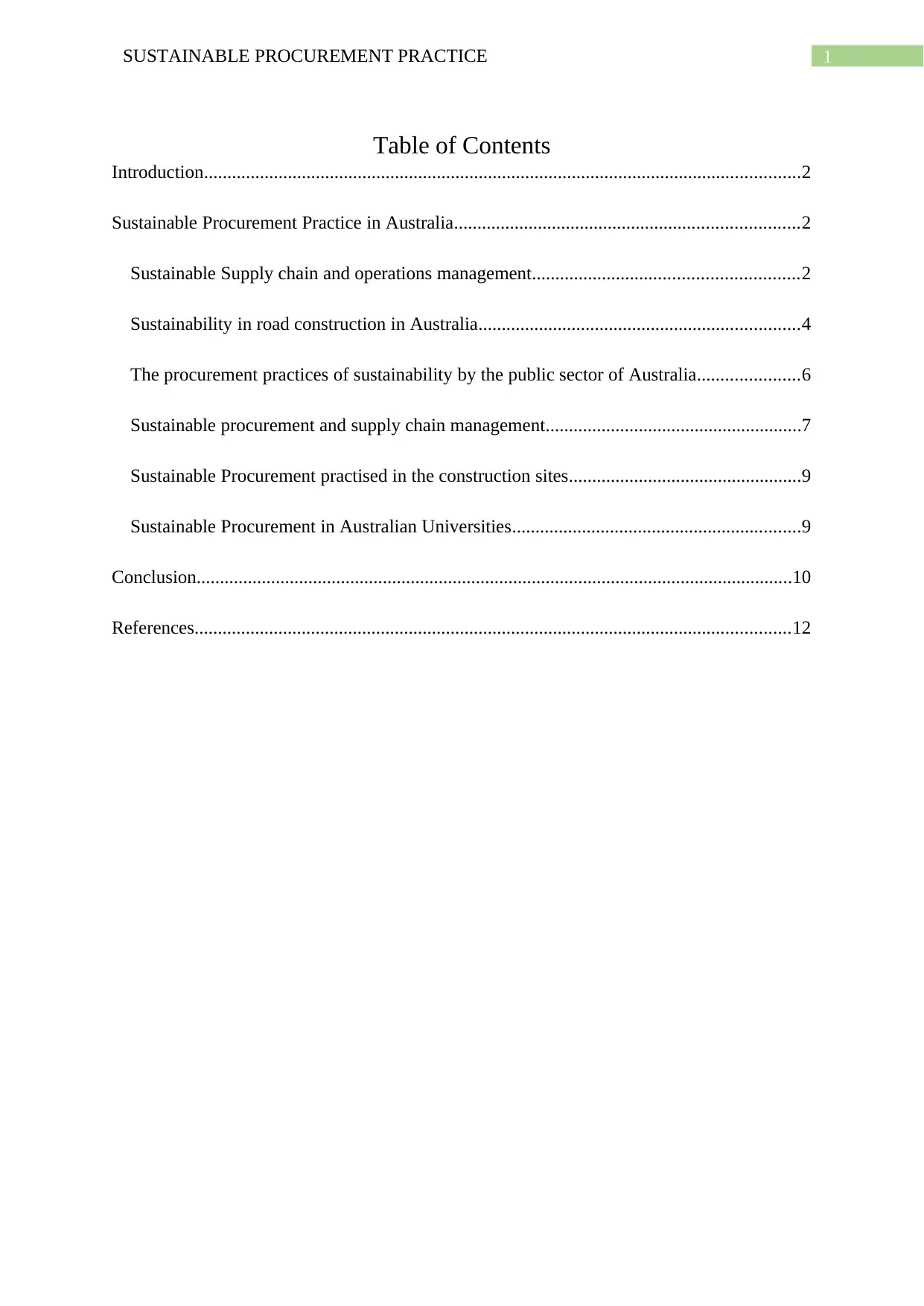
1SUSTAINABLE PROCUREMENT PRACTICE
Table of Contents
Introduction................................................................................................................................2
Sustainable Procurement Practice in Australia..........................................................................2
Sustainable Supply chain and operations management.........................................................2
Sustainability in road construction in Australia.....................................................................4
The procurement practices of sustainability by the public sector of Australia......................6
Sustainable procurement and supply chain management.......................................................7
Sustainable Procurement practised in the construction sites..................................................9
Sustainable Procurement in Australian Universities..............................................................9
Conclusion................................................................................................................................10
References................................................................................................................................12
Table of Contents
Introduction................................................................................................................................2
Sustainable Procurement Practice in Australia..........................................................................2
Sustainable Supply chain and operations management.........................................................2
Sustainability in road construction in Australia.....................................................................4
The procurement practices of sustainability by the public sector of Australia......................6
Sustainable procurement and supply chain management.......................................................7
Sustainable Procurement practised in the construction sites..................................................9
Sustainable Procurement in Australian Universities..............................................................9
Conclusion................................................................................................................................10
References................................................................................................................................12
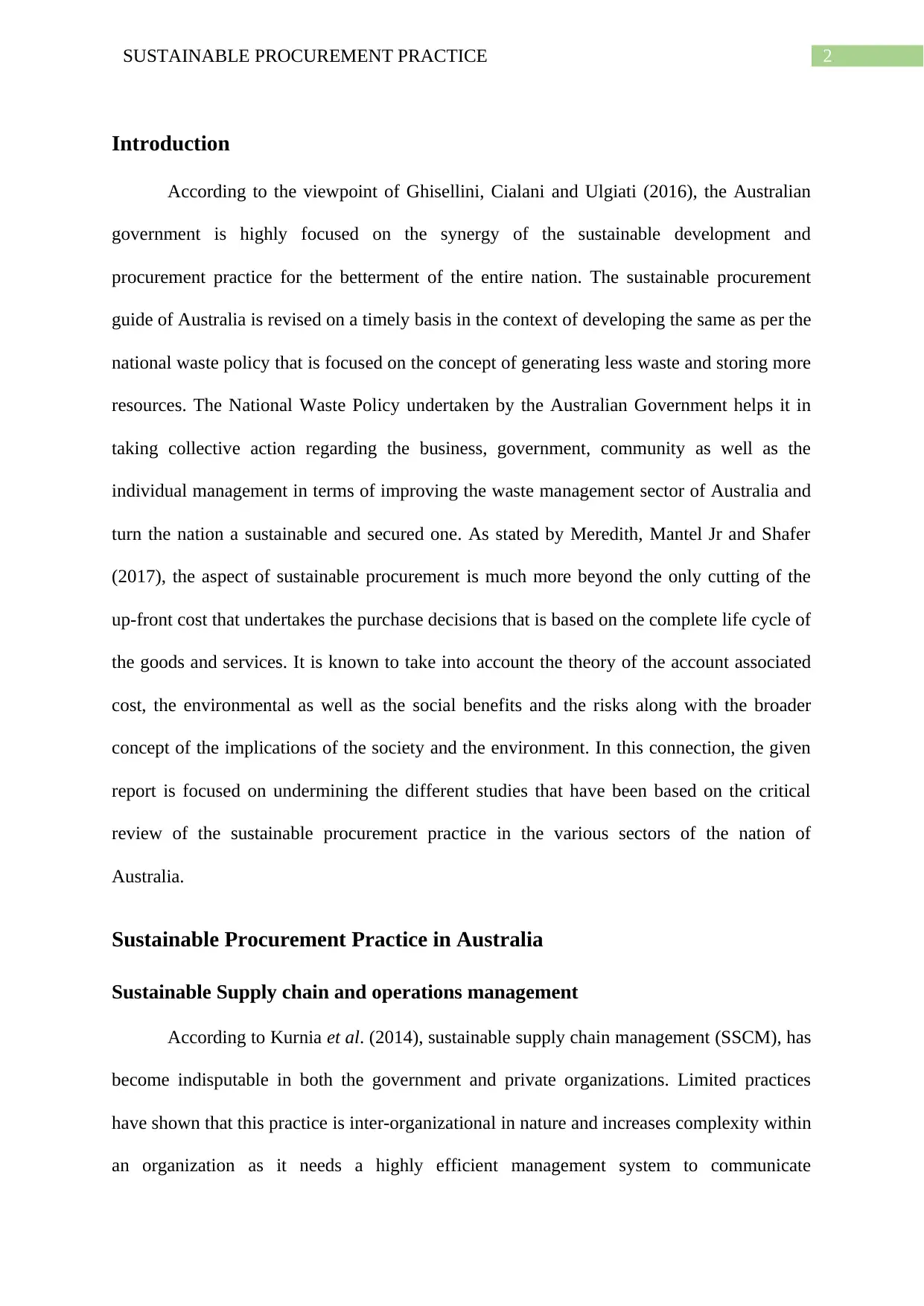
2SUSTAINABLE PROCUREMENT PRACTICE
Introduction
According to the viewpoint of Ghisellini, Cialani and Ulgiati (2016), the Australian
government is highly focused on the synergy of the sustainable development and
procurement practice for the betterment of the entire nation. The sustainable procurement
guide of Australia is revised on a timely basis in the context of developing the same as per the
national waste policy that is focused on the concept of generating less waste and storing more
resources. The National Waste Policy undertaken by the Australian Government helps it in
taking collective action regarding the business, government, community as well as the
individual management in terms of improving the waste management sector of Australia and
turn the nation a sustainable and secured one. As stated by Meredith, Mantel Jr and Shafer
(2017), the aspect of sustainable procurement is much more beyond the only cutting of the
up-front cost that undertakes the purchase decisions that is based on the complete life cycle of
the goods and services. It is known to take into account the theory of the account associated
cost, the environmental as well as the social benefits and the risks along with the broader
concept of the implications of the society and the environment. In this connection, the given
report is focused on undermining the different studies that have been based on the critical
review of the sustainable procurement practice in the various sectors of the nation of
Australia.
Sustainable Procurement Practice in Australia
Sustainable Supply chain and operations management
According to Kurnia et al. (2014), sustainable supply chain management (SSCM), has
become indisputable in both the government and private organizations. Limited practices
have shown that this practice is inter-organizational in nature and increases complexity within
an organization as it needs a highly efficient management system to communicate
Introduction
According to the viewpoint of Ghisellini, Cialani and Ulgiati (2016), the Australian
government is highly focused on the synergy of the sustainable development and
procurement practice for the betterment of the entire nation. The sustainable procurement
guide of Australia is revised on a timely basis in the context of developing the same as per the
national waste policy that is focused on the concept of generating less waste and storing more
resources. The National Waste Policy undertaken by the Australian Government helps it in
taking collective action regarding the business, government, community as well as the
individual management in terms of improving the waste management sector of Australia and
turn the nation a sustainable and secured one. As stated by Meredith, Mantel Jr and Shafer
(2017), the aspect of sustainable procurement is much more beyond the only cutting of the
up-front cost that undertakes the purchase decisions that is based on the complete life cycle of
the goods and services. It is known to take into account the theory of the account associated
cost, the environmental as well as the social benefits and the risks along with the broader
concept of the implications of the society and the environment. In this connection, the given
report is focused on undermining the different studies that have been based on the critical
review of the sustainable procurement practice in the various sectors of the nation of
Australia.
Sustainable Procurement Practice in Australia
Sustainable Supply chain and operations management
According to Kurnia et al. (2014), sustainable supply chain management (SSCM), has
become indisputable in both the government and private organizations. Limited practices
have shown that this practice is inter-organizational in nature and increases complexity within
an organization as it needs a highly efficient management system to communicate
⊘ This is a preview!⊘
Do you want full access?
Subscribe today to unlock all pages.

Trusted by 1+ million students worldwide
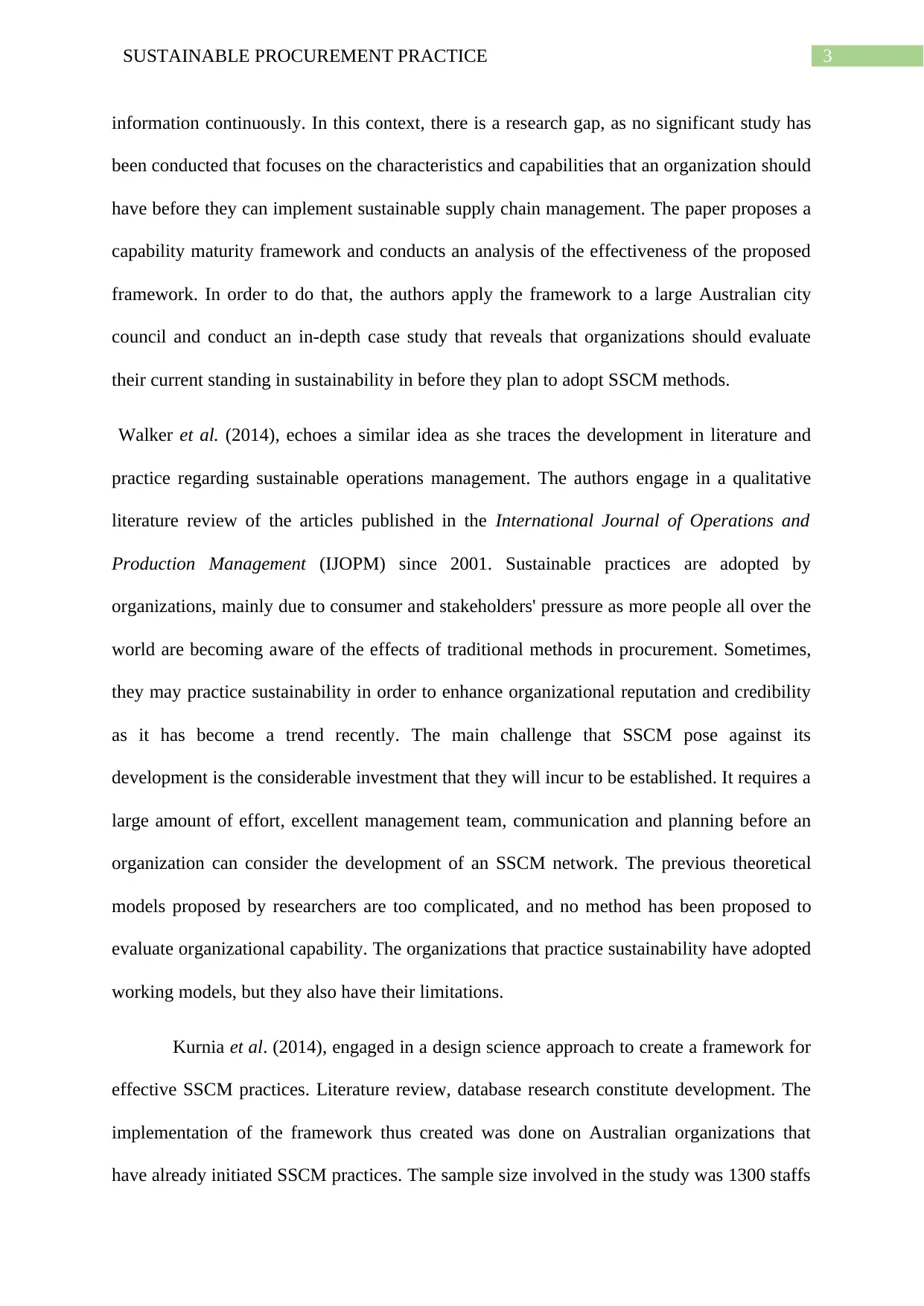
3SUSTAINABLE PROCUREMENT PRACTICE
information continuously. In this context, there is a research gap, as no significant study has
been conducted that focuses on the characteristics and capabilities that an organization should
have before they can implement sustainable supply chain management. The paper proposes a
capability maturity framework and conducts an analysis of the effectiveness of the proposed
framework. In order to do that, the authors apply the framework to a large Australian city
council and conduct an in-depth case study that reveals that organizations should evaluate
their current standing in sustainability in before they plan to adopt SSCM methods.
Walker et al. (2014), echoes a similar idea as she traces the development in literature and
practice regarding sustainable operations management. The authors engage in a qualitative
literature review of the articles published in the International Journal of Operations and
Production Management (IJOPM) since 2001. Sustainable practices are adopted by
organizations, mainly due to consumer and stakeholders' pressure as more people all over the
world are becoming aware of the effects of traditional methods in procurement. Sometimes,
they may practice sustainability in order to enhance organizational reputation and credibility
as it has become a trend recently. The main challenge that SSCM pose against its
development is the considerable investment that they will incur to be established. It requires a
large amount of effort, excellent management team, communication and planning before an
organization can consider the development of an SSCM network. The previous theoretical
models proposed by researchers are too complicated, and no method has been proposed to
evaluate organizational capability. The organizations that practice sustainability have adopted
working models, but they also have their limitations.
Kurnia et al. (2014), engaged in a design science approach to create a framework for
effective SSCM practices. Literature review, database research constitute development. The
implementation of the framework thus created was done on Australian organizations that
have already initiated SSCM practices. The sample size involved in the study was 1300 staffs
information continuously. In this context, there is a research gap, as no significant study has
been conducted that focuses on the characteristics and capabilities that an organization should
have before they can implement sustainable supply chain management. The paper proposes a
capability maturity framework and conducts an analysis of the effectiveness of the proposed
framework. In order to do that, the authors apply the framework to a large Australian city
council and conduct an in-depth case study that reveals that organizations should evaluate
their current standing in sustainability in before they plan to adopt SSCM methods.
Walker et al. (2014), echoes a similar idea as she traces the development in literature and
practice regarding sustainable operations management. The authors engage in a qualitative
literature review of the articles published in the International Journal of Operations and
Production Management (IJOPM) since 2001. Sustainable practices are adopted by
organizations, mainly due to consumer and stakeholders' pressure as more people all over the
world are becoming aware of the effects of traditional methods in procurement. Sometimes,
they may practice sustainability in order to enhance organizational reputation and credibility
as it has become a trend recently. The main challenge that SSCM pose against its
development is the considerable investment that they will incur to be established. It requires a
large amount of effort, excellent management team, communication and planning before an
organization can consider the development of an SSCM network. The previous theoretical
models proposed by researchers are too complicated, and no method has been proposed to
evaluate organizational capability. The organizations that practice sustainability have adopted
working models, but they also have their limitations.
Kurnia et al. (2014), engaged in a design science approach to create a framework for
effective SSCM practices. Literature review, database research constitute development. The
implementation of the framework thus created was done on Australian organizations that
have already initiated SSCM practices. The sample size involved in the study was 1300 staffs
Paraphrase This Document
Need a fresh take? Get an instant paraphrase of this document with our AI Paraphraser
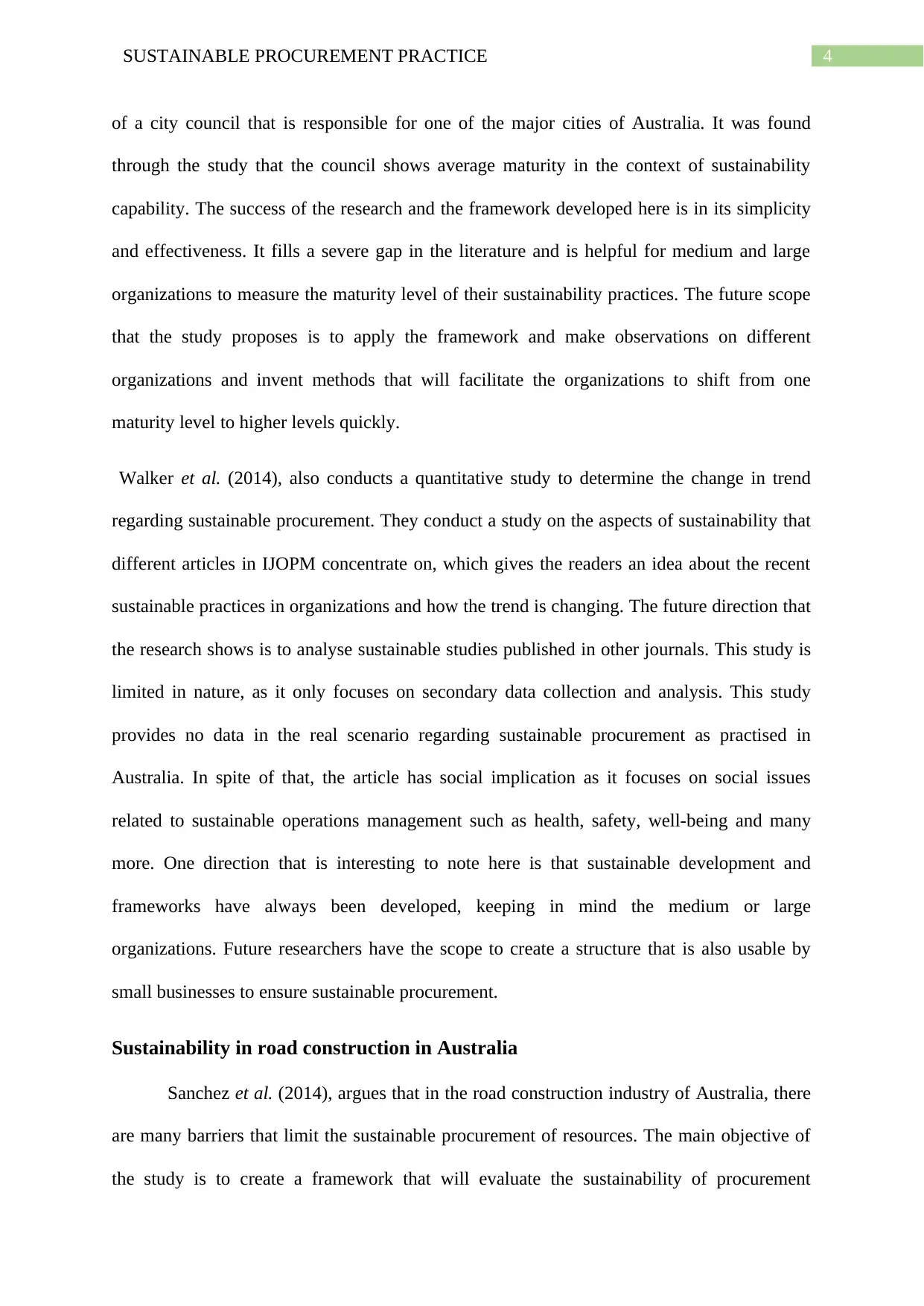
4SUSTAINABLE PROCUREMENT PRACTICE
of a city council that is responsible for one of the major cities of Australia. It was found
through the study that the council shows average maturity in the context of sustainability
capability. The success of the research and the framework developed here is in its simplicity
and effectiveness. It fills a severe gap in the literature and is helpful for medium and large
organizations to measure the maturity level of their sustainability practices. The future scope
that the study proposes is to apply the framework and make observations on different
organizations and invent methods that will facilitate the organizations to shift from one
maturity level to higher levels quickly.
Walker et al. (2014), also conducts a quantitative study to determine the change in trend
regarding sustainable procurement. They conduct a study on the aspects of sustainability that
different articles in IJOPM concentrate on, which gives the readers an idea about the recent
sustainable practices in organizations and how the trend is changing. The future direction that
the research shows is to analyse sustainable studies published in other journals. This study is
limited in nature, as it only focuses on secondary data collection and analysis. This study
provides no data in the real scenario regarding sustainable procurement as practised in
Australia. In spite of that, the article has social implication as it focuses on social issues
related to sustainable operations management such as health, safety, well-being and many
more. One direction that is interesting to note here is that sustainable development and
frameworks have always been developed, keeping in mind the medium or large
organizations. Future researchers have the scope to create a structure that is also usable by
small businesses to ensure sustainable procurement.
Sustainability in road construction in Australia
Sanchez et al. (2014), argues that in the road construction industry of Australia, there
are many barriers that limit the sustainable procurement of resources. The main objective of
the study is to create a framework that will evaluate the sustainability of procurement
of a city council that is responsible for one of the major cities of Australia. It was found
through the study that the council shows average maturity in the context of sustainability
capability. The success of the research and the framework developed here is in its simplicity
and effectiveness. It fills a severe gap in the literature and is helpful for medium and large
organizations to measure the maturity level of their sustainability practices. The future scope
that the study proposes is to apply the framework and make observations on different
organizations and invent methods that will facilitate the organizations to shift from one
maturity level to higher levels quickly.
Walker et al. (2014), also conducts a quantitative study to determine the change in trend
regarding sustainable procurement. They conduct a study on the aspects of sustainability that
different articles in IJOPM concentrate on, which gives the readers an idea about the recent
sustainable practices in organizations and how the trend is changing. The future direction that
the research shows is to analyse sustainable studies published in other journals. This study is
limited in nature, as it only focuses on secondary data collection and analysis. This study
provides no data in the real scenario regarding sustainable procurement as practised in
Australia. In spite of that, the article has social implication as it focuses on social issues
related to sustainable operations management such as health, safety, well-being and many
more. One direction that is interesting to note here is that sustainable development and
frameworks have always been developed, keeping in mind the medium or large
organizations. Future researchers have the scope to create a structure that is also usable by
small businesses to ensure sustainable procurement.
Sustainability in road construction in Australia
Sanchez et al. (2014), argues that in the road construction industry of Australia, there
are many barriers that limit the sustainable procurement of resources. The main objective of
the study is to create a framework that will evaluate the sustainability of procurement
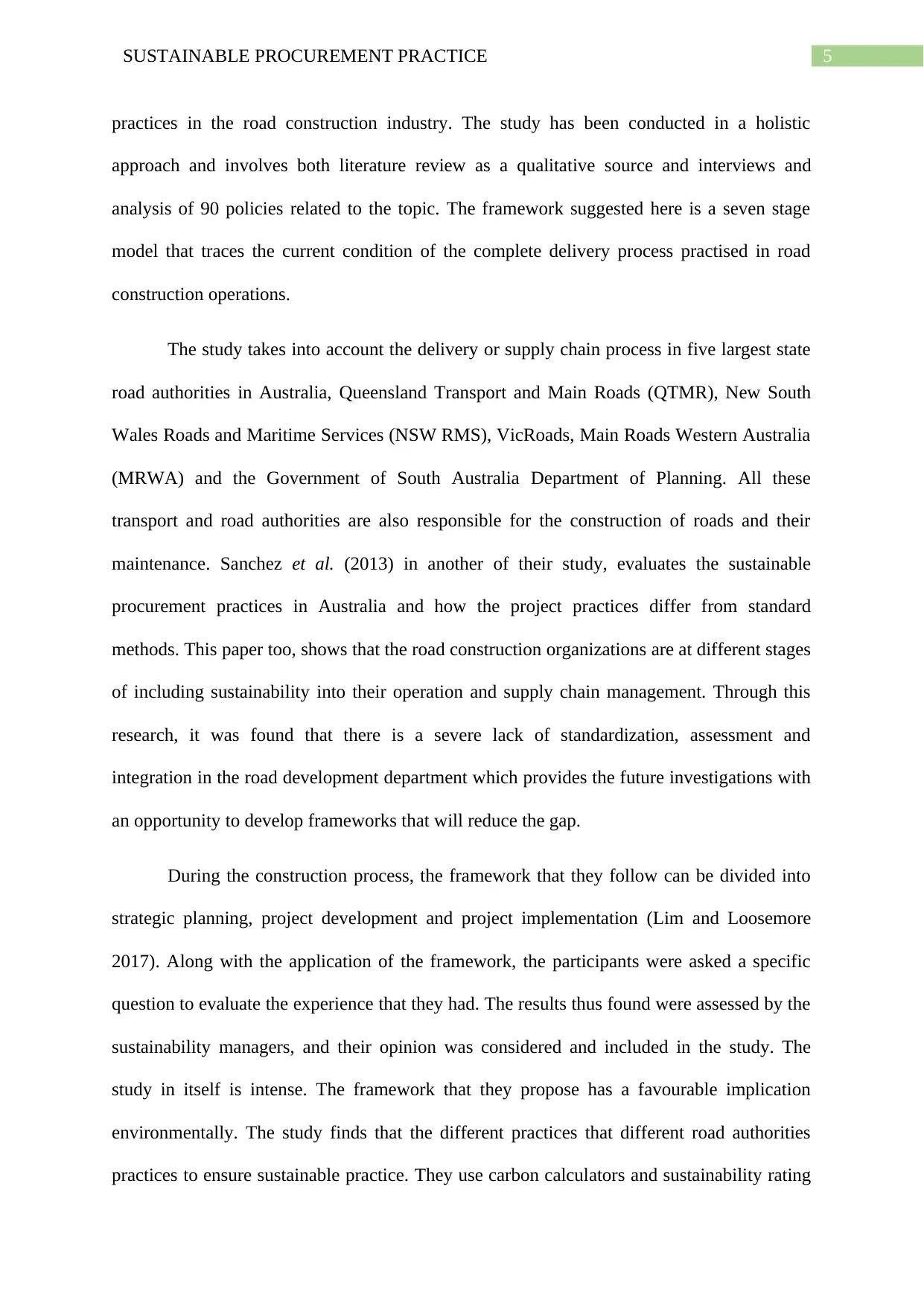
5SUSTAINABLE PROCUREMENT PRACTICE
practices in the road construction industry. The study has been conducted in a holistic
approach and involves both literature review as a qualitative source and interviews and
analysis of 90 policies related to the topic. The framework suggested here is a seven stage
model that traces the current condition of the complete delivery process practised in road
construction operations.
The study takes into account the delivery or supply chain process in five largest state
road authorities in Australia, Queensland Transport and Main Roads (QTMR), New South
Wales Roads and Maritime Services (NSW RMS), VicRoads, Main Roads Western Australia
(MRWA) and the Government of South Australia Department of Planning. All these
transport and road authorities are also responsible for the construction of roads and their
maintenance. Sanchez et al. (2013) in another of their study, evaluates the sustainable
procurement practices in Australia and how the project practices differ from standard
methods. This paper too, shows that the road construction organizations are at different stages
of including sustainability into their operation and supply chain management. Through this
research, it was found that there is a severe lack of standardization, assessment and
integration in the road development department which provides the future investigations with
an opportunity to develop frameworks that will reduce the gap.
During the construction process, the framework that they follow can be divided into
strategic planning, project development and project implementation (Lim and Loosemore
2017). Along with the application of the framework, the participants were asked a specific
question to evaluate the experience that they had. The results thus found were assessed by the
sustainability managers, and their opinion was considered and included in the study. The
study in itself is intense. The framework that they propose has a favourable implication
environmentally. The study finds that the different practices that different road authorities
practices to ensure sustainable practice. They use carbon calculators and sustainability rating
practices in the road construction industry. The study has been conducted in a holistic
approach and involves both literature review as a qualitative source and interviews and
analysis of 90 policies related to the topic. The framework suggested here is a seven stage
model that traces the current condition of the complete delivery process practised in road
construction operations.
The study takes into account the delivery or supply chain process in five largest state
road authorities in Australia, Queensland Transport and Main Roads (QTMR), New South
Wales Roads and Maritime Services (NSW RMS), VicRoads, Main Roads Western Australia
(MRWA) and the Government of South Australia Department of Planning. All these
transport and road authorities are also responsible for the construction of roads and their
maintenance. Sanchez et al. (2013) in another of their study, evaluates the sustainable
procurement practices in Australia and how the project practices differ from standard
methods. This paper too, shows that the road construction organizations are at different stages
of including sustainability into their operation and supply chain management. Through this
research, it was found that there is a severe lack of standardization, assessment and
integration in the road development department which provides the future investigations with
an opportunity to develop frameworks that will reduce the gap.
During the construction process, the framework that they follow can be divided into
strategic planning, project development and project implementation (Lim and Loosemore
2017). Along with the application of the framework, the participants were asked a specific
question to evaluate the experience that they had. The results thus found were assessed by the
sustainability managers, and their opinion was considered and included in the study. The
study in itself is intense. The framework that they propose has a favourable implication
environmentally. The study finds that the different practices that different road authorities
practices to ensure sustainable practice. They use carbon calculators and sustainability rating
⊘ This is a preview!⊘
Do you want full access?
Subscribe today to unlock all pages.

Trusted by 1+ million students worldwide
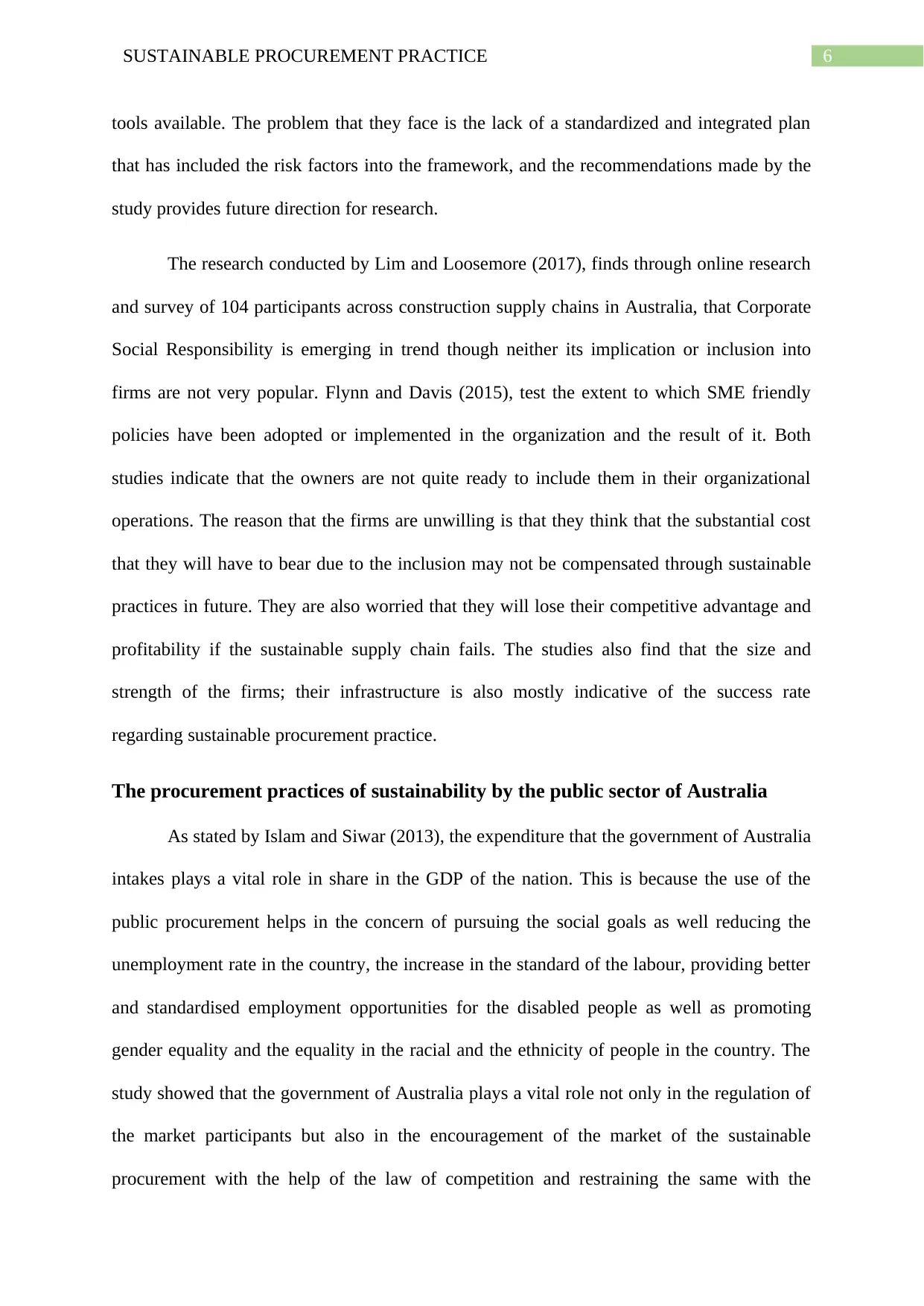
6SUSTAINABLE PROCUREMENT PRACTICE
tools available. The problem that they face is the lack of a standardized and integrated plan
that has included the risk factors into the framework, and the recommendations made by the
study provides future direction for research.
The research conducted by Lim and Loosemore (2017), finds through online research
and survey of 104 participants across construction supply chains in Australia, that Corporate
Social Responsibility is emerging in trend though neither its implication or inclusion into
firms are not very popular. Flynn and Davis (2015), test the extent to which SME friendly
policies have been adopted or implemented in the organization and the result of it. Both
studies indicate that the owners are not quite ready to include them in their organizational
operations. The reason that the firms are unwilling is that they think that the substantial cost
that they will have to bear due to the inclusion may not be compensated through sustainable
practices in future. They are also worried that they will lose their competitive advantage and
profitability if the sustainable supply chain fails. The studies also find that the size and
strength of the firms; their infrastructure is also mostly indicative of the success rate
regarding sustainable procurement practice.
The procurement practices of sustainability by the public sector of Australia
As stated by Islam and Siwar (2013), the expenditure that the government of Australia
intakes plays a vital role in share in the GDP of the nation. This is because the use of the
public procurement helps in the concern of pursuing the social goals as well reducing the
unemployment rate in the country, the increase in the standard of the labour, providing better
and standardised employment opportunities for the disabled people as well as promoting
gender equality and the equality in the racial and the ethnicity of people in the country. The
study showed that the government of Australia plays a vital role not only in the regulation of
the market participants but also in the encouragement of the market of the sustainable
procurement with the help of the law of competition and restraining the same with the
tools available. The problem that they face is the lack of a standardized and integrated plan
that has included the risk factors into the framework, and the recommendations made by the
study provides future direction for research.
The research conducted by Lim and Loosemore (2017), finds through online research
and survey of 104 participants across construction supply chains in Australia, that Corporate
Social Responsibility is emerging in trend though neither its implication or inclusion into
firms are not very popular. Flynn and Davis (2015), test the extent to which SME friendly
policies have been adopted or implemented in the organization and the result of it. Both
studies indicate that the owners are not quite ready to include them in their organizational
operations. The reason that the firms are unwilling is that they think that the substantial cost
that they will have to bear due to the inclusion may not be compensated through sustainable
practices in future. They are also worried that they will lose their competitive advantage and
profitability if the sustainable supply chain fails. The studies also find that the size and
strength of the firms; their infrastructure is also mostly indicative of the success rate
regarding sustainable procurement practice.
The procurement practices of sustainability by the public sector of Australia
As stated by Islam and Siwar (2013), the expenditure that the government of Australia
intakes plays a vital role in share in the GDP of the nation. This is because the use of the
public procurement helps in the concern of pursuing the social goals as well reducing the
unemployment rate in the country, the increase in the standard of the labour, providing better
and standardised employment opportunities for the disabled people as well as promoting
gender equality and the equality in the racial and the ethnicity of people in the country. The
study showed that the government of Australia plays a vital role not only in the regulation of
the market participants but also in the encouragement of the market of the sustainable
procurement with the help of the law of competition and restraining the same with the
Paraphrase This Document
Need a fresh take? Get an instant paraphrase of this document with our AI Paraphraser
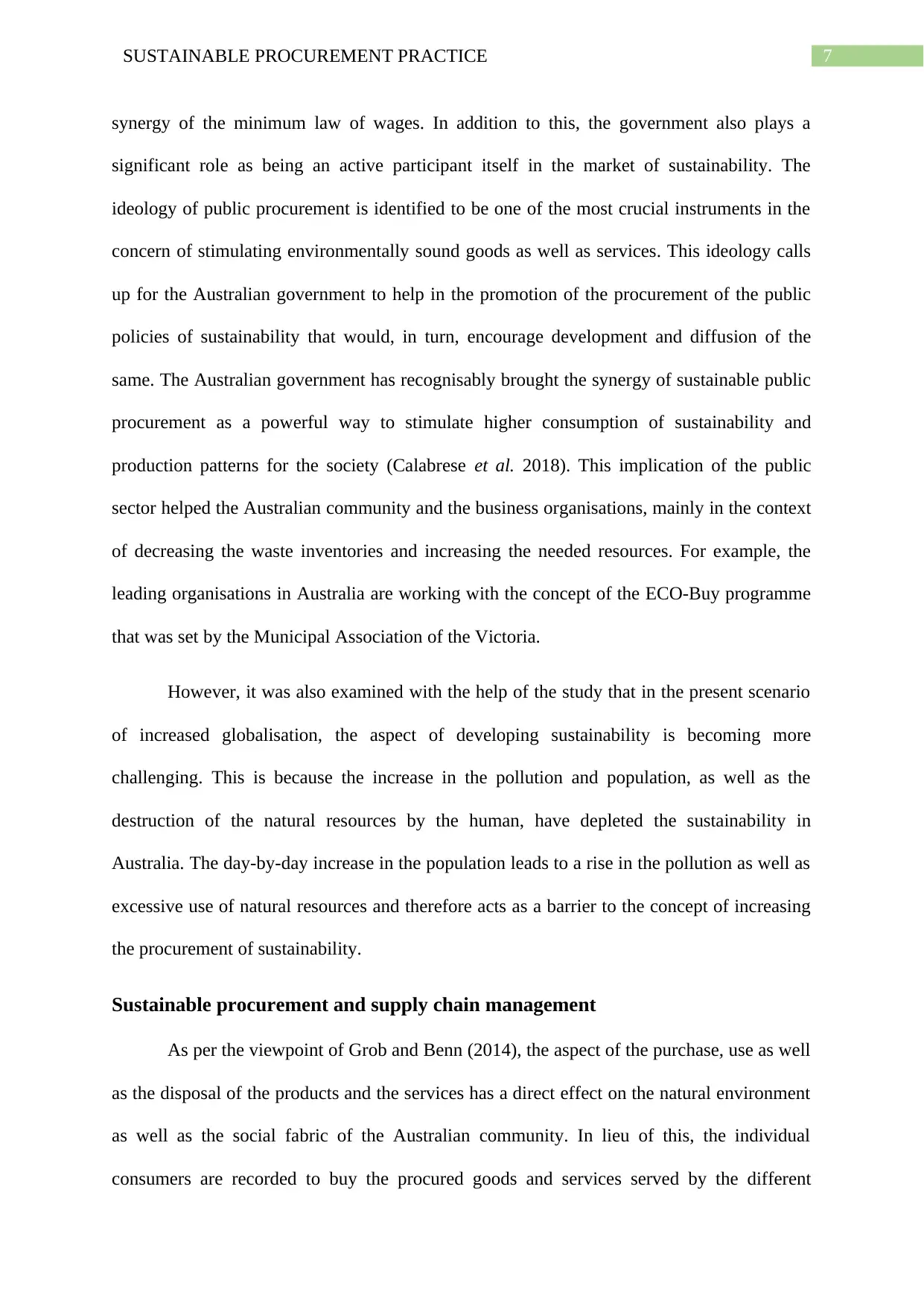
7SUSTAINABLE PROCUREMENT PRACTICE
synergy of the minimum law of wages. In addition to this, the government also plays a
significant role as being an active participant itself in the market of sustainability. The
ideology of public procurement is identified to be one of the most crucial instruments in the
concern of stimulating environmentally sound goods as well as services. This ideology calls
up for the Australian government to help in the promotion of the procurement of the public
policies of sustainability that would, in turn, encourage development and diffusion of the
same. The Australian government has recognisably brought the synergy of sustainable public
procurement as a powerful way to stimulate higher consumption of sustainability and
production patterns for the society (Calabrese et al. 2018). This implication of the public
sector helped the Australian community and the business organisations, mainly in the context
of decreasing the waste inventories and increasing the needed resources. For example, the
leading organisations in Australia are working with the concept of the ECO-Buy programme
that was set by the Municipal Association of the Victoria.
However, it was also examined with the help of the study that in the present scenario
of increased globalisation, the aspect of developing sustainability is becoming more
challenging. This is because the increase in the pollution and population, as well as the
destruction of the natural resources by the human, have depleted the sustainability in
Australia. The day-by-day increase in the population leads to a rise in the pollution as well as
excessive use of natural resources and therefore acts as a barrier to the concept of increasing
the procurement of sustainability.
Sustainable procurement and supply chain management
As per the viewpoint of Grob and Benn (2014), the aspect of the purchase, use as well
as the disposal of the products and the services has a direct effect on the natural environment
as well as the social fabric of the Australian community. In lieu of this, the individual
consumers are recorded to buy the procured goods and services served by the different
synergy of the minimum law of wages. In addition to this, the government also plays a
significant role as being an active participant itself in the market of sustainability. The
ideology of public procurement is identified to be one of the most crucial instruments in the
concern of stimulating environmentally sound goods as well as services. This ideology calls
up for the Australian government to help in the promotion of the procurement of the public
policies of sustainability that would, in turn, encourage development and diffusion of the
same. The Australian government has recognisably brought the synergy of sustainable public
procurement as a powerful way to stimulate higher consumption of sustainability and
production patterns for the society (Calabrese et al. 2018). This implication of the public
sector helped the Australian community and the business organisations, mainly in the context
of decreasing the waste inventories and increasing the needed resources. For example, the
leading organisations in Australia are working with the concept of the ECO-Buy programme
that was set by the Municipal Association of the Victoria.
However, it was also examined with the help of the study that in the present scenario
of increased globalisation, the aspect of developing sustainability is becoming more
challenging. This is because the increase in the pollution and population, as well as the
destruction of the natural resources by the human, have depleted the sustainability in
Australia. The day-by-day increase in the population leads to a rise in the pollution as well as
excessive use of natural resources and therefore acts as a barrier to the concept of increasing
the procurement of sustainability.
Sustainable procurement and supply chain management
As per the viewpoint of Grob and Benn (2014), the aspect of the purchase, use as well
as the disposal of the products and the services has a direct effect on the natural environment
as well as the social fabric of the Australian community. In lieu of this, the individual
consumers are recorded to buy the procured goods and services served by the different
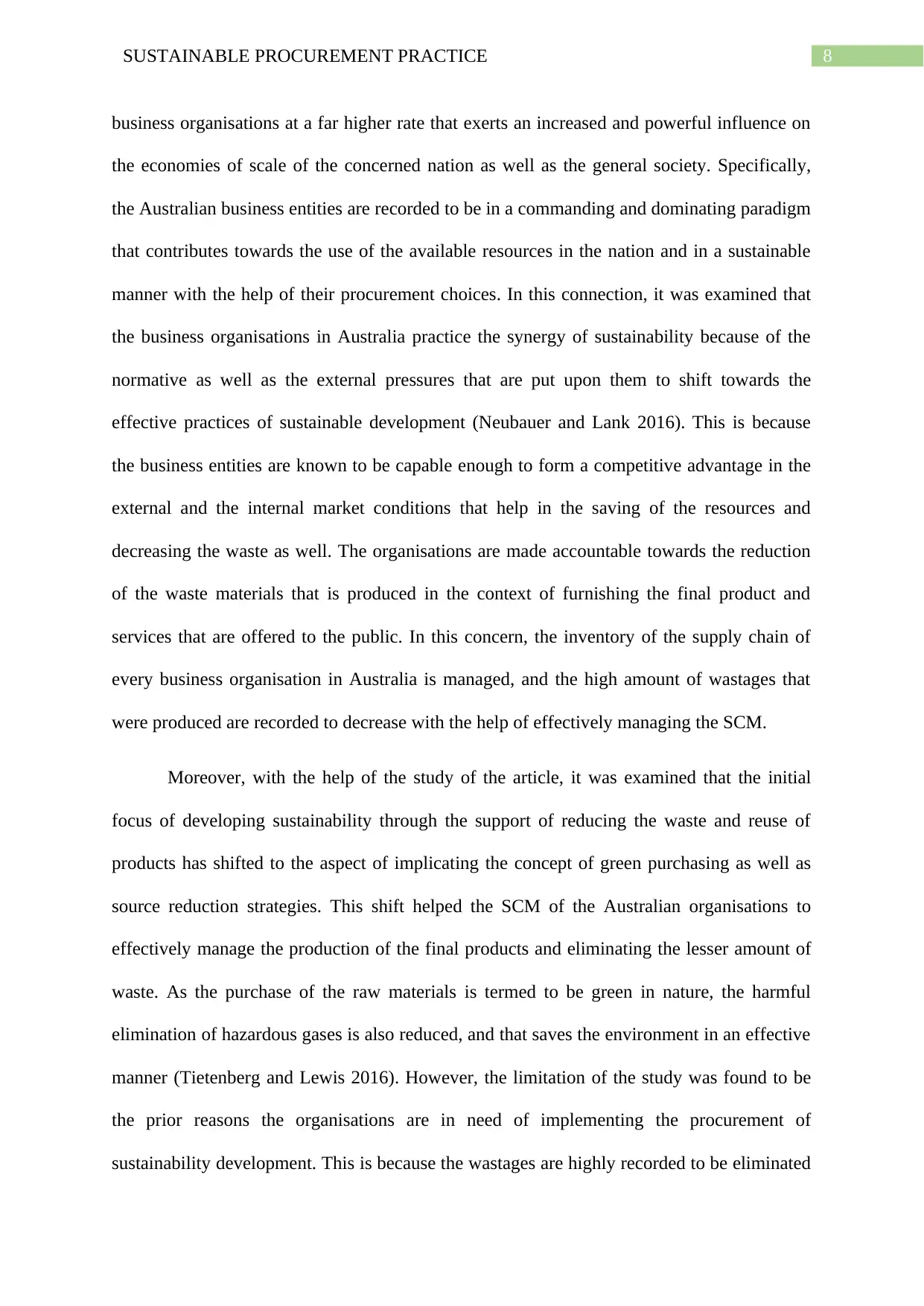
8SUSTAINABLE PROCUREMENT PRACTICE
business organisations at a far higher rate that exerts an increased and powerful influence on
the economies of scale of the concerned nation as well as the general society. Specifically,
the Australian business entities are recorded to be in a commanding and dominating paradigm
that contributes towards the use of the available resources in the nation and in a sustainable
manner with the help of their procurement choices. In this connection, it was examined that
the business organisations in Australia practice the synergy of sustainability because of the
normative as well as the external pressures that are put upon them to shift towards the
effective practices of sustainable development (Neubauer and Lank 2016). This is because
the business entities are known to be capable enough to form a competitive advantage in the
external and the internal market conditions that help in the saving of the resources and
decreasing the waste as well. The organisations are made accountable towards the reduction
of the waste materials that is produced in the context of furnishing the final product and
services that are offered to the public. In this concern, the inventory of the supply chain of
every business organisation in Australia is managed, and the high amount of wastages that
were produced are recorded to decrease with the help of effectively managing the SCM.
Moreover, with the help of the study of the article, it was examined that the initial
focus of developing sustainability through the support of reducing the waste and reuse of
products has shifted to the aspect of implicating the concept of green purchasing as well as
source reduction strategies. This shift helped the SCM of the Australian organisations to
effectively manage the production of the final products and eliminating the lesser amount of
waste. As the purchase of the raw materials is termed to be green in nature, the harmful
elimination of hazardous gases is also reduced, and that saves the environment in an effective
manner (Tietenberg and Lewis 2016). However, the limitation of the study was found to be
the prior reasons the organisations are in need of implementing the procurement of
sustainability development. This is because the wastages are highly recorded to be eliminated
business organisations at a far higher rate that exerts an increased and powerful influence on
the economies of scale of the concerned nation as well as the general society. Specifically,
the Australian business entities are recorded to be in a commanding and dominating paradigm
that contributes towards the use of the available resources in the nation and in a sustainable
manner with the help of their procurement choices. In this connection, it was examined that
the business organisations in Australia practice the synergy of sustainability because of the
normative as well as the external pressures that are put upon them to shift towards the
effective practices of sustainable development (Neubauer and Lank 2016). This is because
the business entities are known to be capable enough to form a competitive advantage in the
external and the internal market conditions that help in the saving of the resources and
decreasing the waste as well. The organisations are made accountable towards the reduction
of the waste materials that is produced in the context of furnishing the final product and
services that are offered to the public. In this concern, the inventory of the supply chain of
every business organisation in Australia is managed, and the high amount of wastages that
were produced are recorded to decrease with the help of effectively managing the SCM.
Moreover, with the help of the study of the article, it was examined that the initial
focus of developing sustainability through the support of reducing the waste and reuse of
products has shifted to the aspect of implicating the concept of green purchasing as well as
source reduction strategies. This shift helped the SCM of the Australian organisations to
effectively manage the production of the final products and eliminating the lesser amount of
waste. As the purchase of the raw materials is termed to be green in nature, the harmful
elimination of hazardous gases is also reduced, and that saves the environment in an effective
manner (Tietenberg and Lewis 2016). However, the limitation of the study was found to be
the prior reasons the organisations are in need of implementing the procurement of
sustainability development. This is because the wastages are highly recorded to be eliminated
⊘ This is a preview!⊘
Do you want full access?
Subscribe today to unlock all pages.

Trusted by 1+ million students worldwide
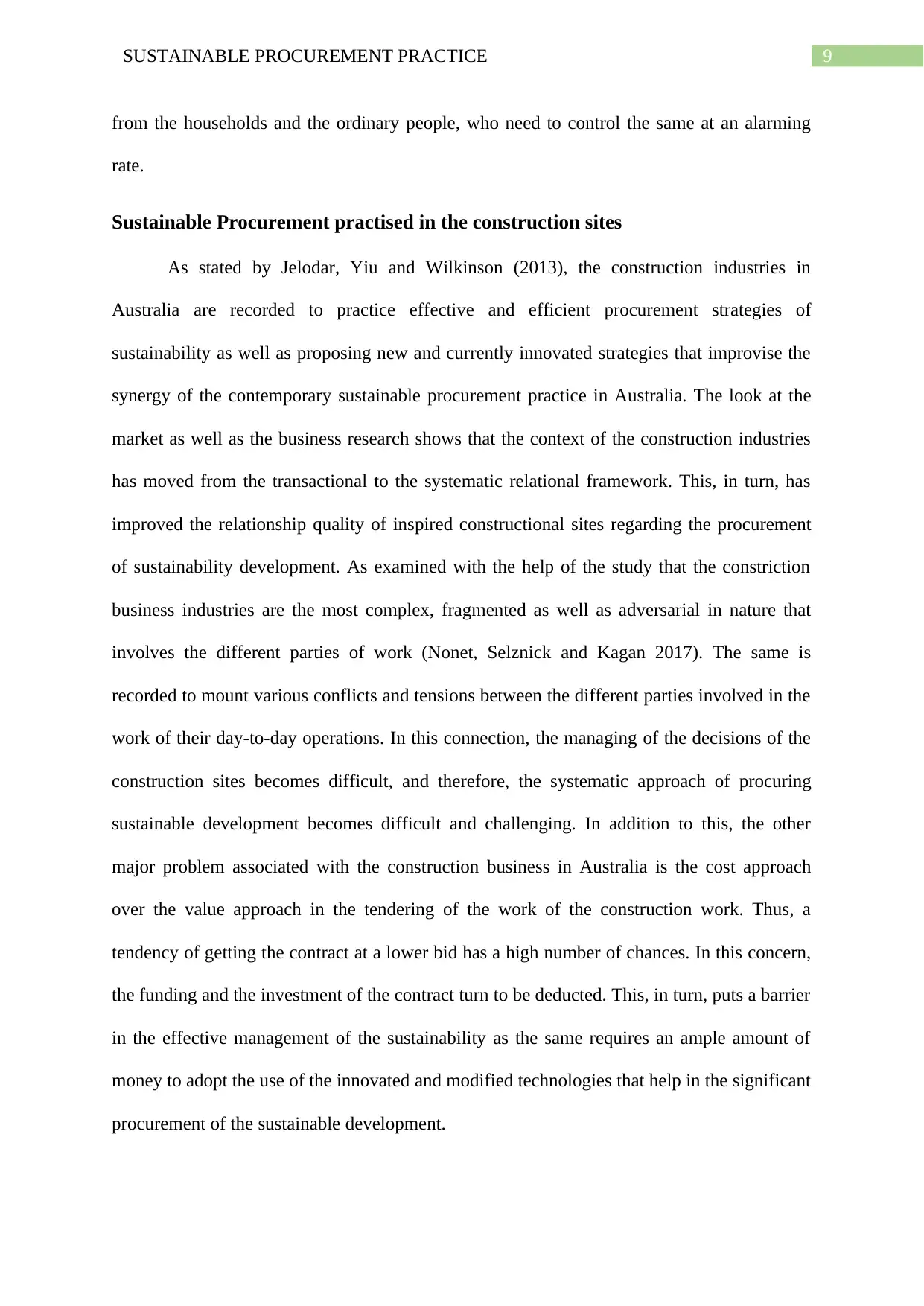
9SUSTAINABLE PROCUREMENT PRACTICE
from the households and the ordinary people, who need to control the same at an alarming
rate.
Sustainable Procurement practised in the construction sites
As stated by Jelodar, Yiu and Wilkinson (2013), the construction industries in
Australia are recorded to practice effective and efficient procurement strategies of
sustainability as well as proposing new and currently innovated strategies that improvise the
synergy of the contemporary sustainable procurement practice in Australia. The look at the
market as well as the business research shows that the context of the construction industries
has moved from the transactional to the systematic relational framework. This, in turn, has
improved the relationship quality of inspired constructional sites regarding the procurement
of sustainability development. As examined with the help of the study that the constriction
business industries are the most complex, fragmented as well as adversarial in nature that
involves the different parties of work (Nonet, Selznick and Kagan 2017). The same is
recorded to mount various conflicts and tensions between the different parties involved in the
work of their day-to-day operations. In this connection, the managing of the decisions of the
construction sites becomes difficult, and therefore, the systematic approach of procuring
sustainable development becomes difficult and challenging. In addition to this, the other
major problem associated with the construction business in Australia is the cost approach
over the value approach in the tendering of the work of the construction work. Thus, a
tendency of getting the contract at a lower bid has a high number of chances. In this concern,
the funding and the investment of the contract turn to be deducted. This, in turn, puts a barrier
in the effective management of the sustainability as the same requires an ample amount of
money to adopt the use of the innovated and modified technologies that help in the significant
procurement of the sustainable development.
from the households and the ordinary people, who need to control the same at an alarming
rate.
Sustainable Procurement practised in the construction sites
As stated by Jelodar, Yiu and Wilkinson (2013), the construction industries in
Australia are recorded to practice effective and efficient procurement strategies of
sustainability as well as proposing new and currently innovated strategies that improvise the
synergy of the contemporary sustainable procurement practice in Australia. The look at the
market as well as the business research shows that the context of the construction industries
has moved from the transactional to the systematic relational framework. This, in turn, has
improved the relationship quality of inspired constructional sites regarding the procurement
of sustainability development. As examined with the help of the study that the constriction
business industries are the most complex, fragmented as well as adversarial in nature that
involves the different parties of work (Nonet, Selznick and Kagan 2017). The same is
recorded to mount various conflicts and tensions between the different parties involved in the
work of their day-to-day operations. In this connection, the managing of the decisions of the
construction sites becomes difficult, and therefore, the systematic approach of procuring
sustainable development becomes difficult and challenging. In addition to this, the other
major problem associated with the construction business in Australia is the cost approach
over the value approach in the tendering of the work of the construction work. Thus, a
tendency of getting the contract at a lower bid has a high number of chances. In this concern,
the funding and the investment of the contract turn to be deducted. This, in turn, puts a barrier
in the effective management of the sustainability as the same requires an ample amount of
money to adopt the use of the innovated and modified technologies that help in the significant
procurement of the sustainable development.
Paraphrase This Document
Need a fresh take? Get an instant paraphrase of this document with our AI Paraphraser
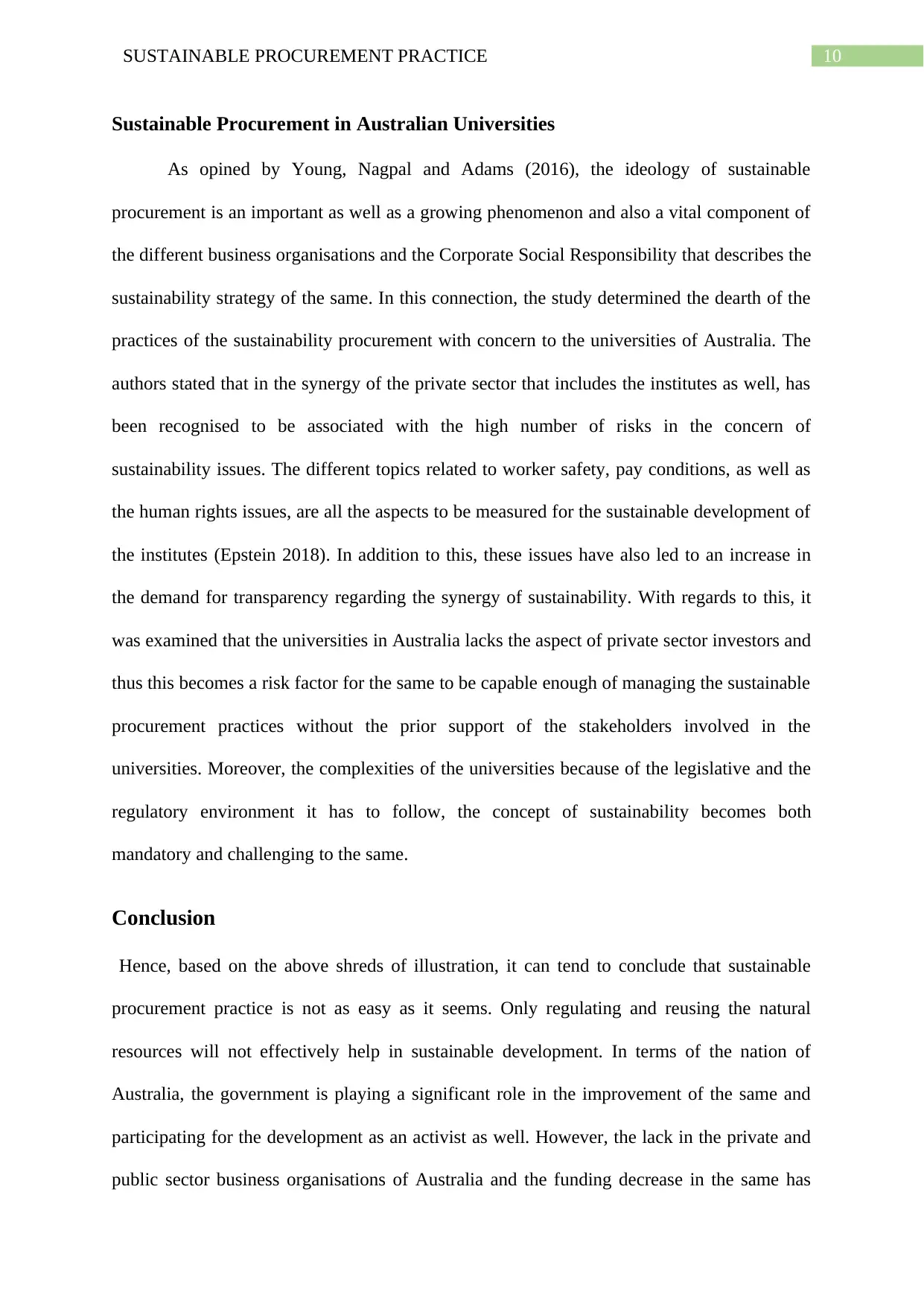
10SUSTAINABLE PROCUREMENT PRACTICE
Sustainable Procurement in Australian Universities
As opined by Young, Nagpal and Adams (2016), the ideology of sustainable
procurement is an important as well as a growing phenomenon and also a vital component of
the different business organisations and the Corporate Social Responsibility that describes the
sustainability strategy of the same. In this connection, the study determined the dearth of the
practices of the sustainability procurement with concern to the universities of Australia. The
authors stated that in the synergy of the private sector that includes the institutes as well, has
been recognised to be associated with the high number of risks in the concern of
sustainability issues. The different topics related to worker safety, pay conditions, as well as
the human rights issues, are all the aspects to be measured for the sustainable development of
the institutes (Epstein 2018). In addition to this, these issues have also led to an increase in
the demand for transparency regarding the synergy of sustainability. With regards to this, it
was examined that the universities in Australia lacks the aspect of private sector investors and
thus this becomes a risk factor for the same to be capable enough of managing the sustainable
procurement practices without the prior support of the stakeholders involved in the
universities. Moreover, the complexities of the universities because of the legislative and the
regulatory environment it has to follow, the concept of sustainability becomes both
mandatory and challenging to the same.
Conclusion
Hence, based on the above shreds of illustration, it can tend to conclude that sustainable
procurement practice is not as easy as it seems. Only regulating and reusing the natural
resources will not effectively help in sustainable development. In terms of the nation of
Australia, the government is playing a significant role in the improvement of the same and
participating for the development as an activist as well. However, the lack in the private and
public sector business organisations of Australia and the funding decrease in the same has
Sustainable Procurement in Australian Universities
As opined by Young, Nagpal and Adams (2016), the ideology of sustainable
procurement is an important as well as a growing phenomenon and also a vital component of
the different business organisations and the Corporate Social Responsibility that describes the
sustainability strategy of the same. In this connection, the study determined the dearth of the
practices of the sustainability procurement with concern to the universities of Australia. The
authors stated that in the synergy of the private sector that includes the institutes as well, has
been recognised to be associated with the high number of risks in the concern of
sustainability issues. The different topics related to worker safety, pay conditions, as well as
the human rights issues, are all the aspects to be measured for the sustainable development of
the institutes (Epstein 2018). In addition to this, these issues have also led to an increase in
the demand for transparency regarding the synergy of sustainability. With regards to this, it
was examined that the universities in Australia lacks the aspect of private sector investors and
thus this becomes a risk factor for the same to be capable enough of managing the sustainable
procurement practices without the prior support of the stakeholders involved in the
universities. Moreover, the complexities of the universities because of the legislative and the
regulatory environment it has to follow, the concept of sustainability becomes both
mandatory and challenging to the same.
Conclusion
Hence, based on the above shreds of illustration, it can tend to conclude that sustainable
procurement practice is not as easy as it seems. Only regulating and reusing the natural
resources will not effectively help in sustainable development. In terms of the nation of
Australia, the government is playing a significant role in the improvement of the same and
participating for the development as an activist as well. However, the lack in the private and
public sector business organisations of Australia and the funding decrease in the same has
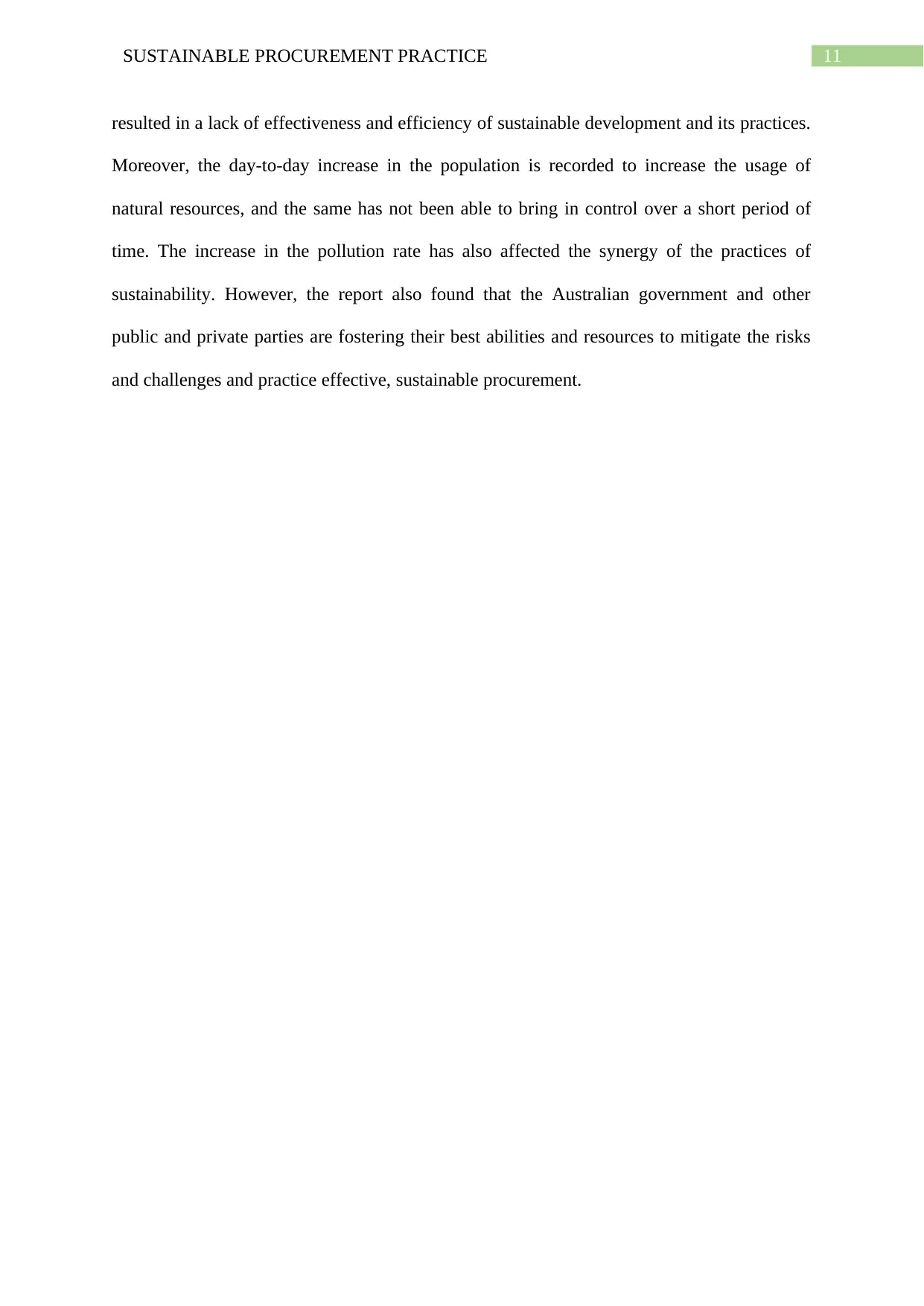
11SUSTAINABLE PROCUREMENT PRACTICE
resulted in a lack of effectiveness and efficiency of sustainable development and its practices.
Moreover, the day-to-day increase in the population is recorded to increase the usage of
natural resources, and the same has not been able to bring in control over a short period of
time. The increase in the pollution rate has also affected the synergy of the practices of
sustainability. However, the report also found that the Australian government and other
public and private parties are fostering their best abilities and resources to mitigate the risks
and challenges and practice effective, sustainable procurement.
resulted in a lack of effectiveness and efficiency of sustainable development and its practices.
Moreover, the day-to-day increase in the population is recorded to increase the usage of
natural resources, and the same has not been able to bring in control over a short period of
time. The increase in the pollution rate has also affected the synergy of the practices of
sustainability. However, the report also found that the Australian government and other
public and private parties are fostering their best abilities and resources to mitigate the risks
and challenges and practice effective, sustainable procurement.
⊘ This is a preview!⊘
Do you want full access?
Subscribe today to unlock all pages.

Trusted by 1+ million students worldwide
1 out of 14
Related Documents
Your All-in-One AI-Powered Toolkit for Academic Success.
+13062052269
info@desklib.com
Available 24*7 on WhatsApp / Email
![[object Object]](/_next/static/media/star-bottom.7253800d.svg)
Unlock your academic potential
Copyright © 2020–2025 A2Z Services. All Rights Reserved. Developed and managed by ZUCOL.





